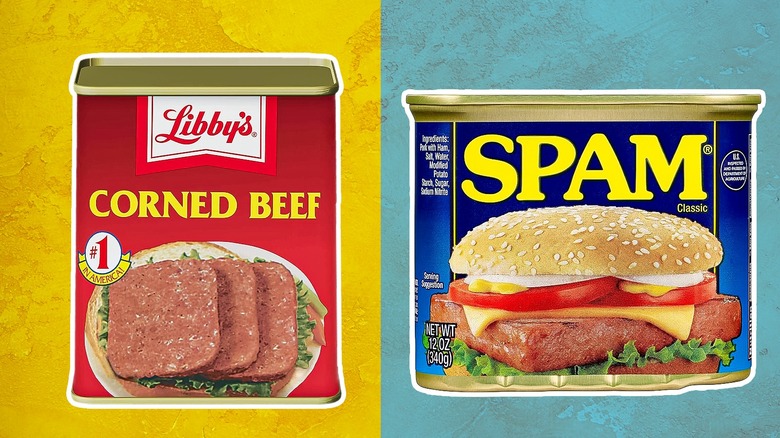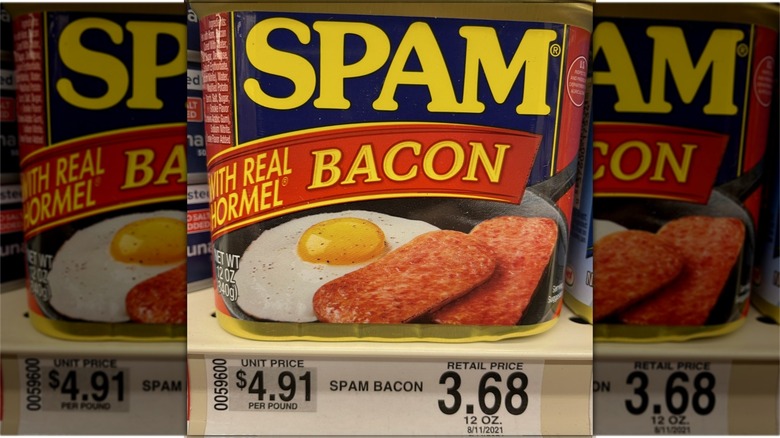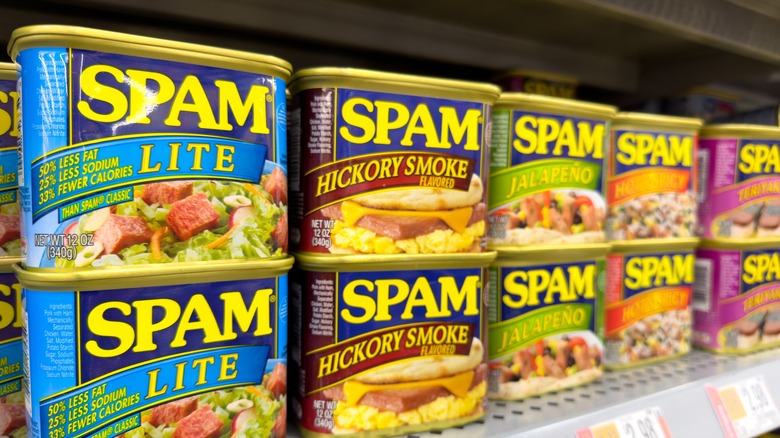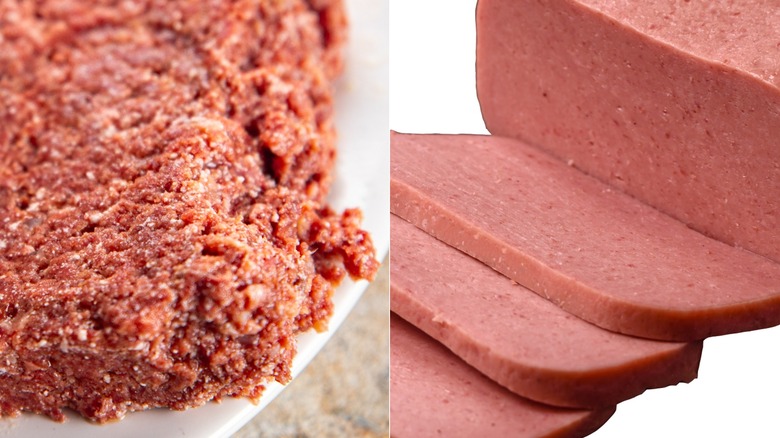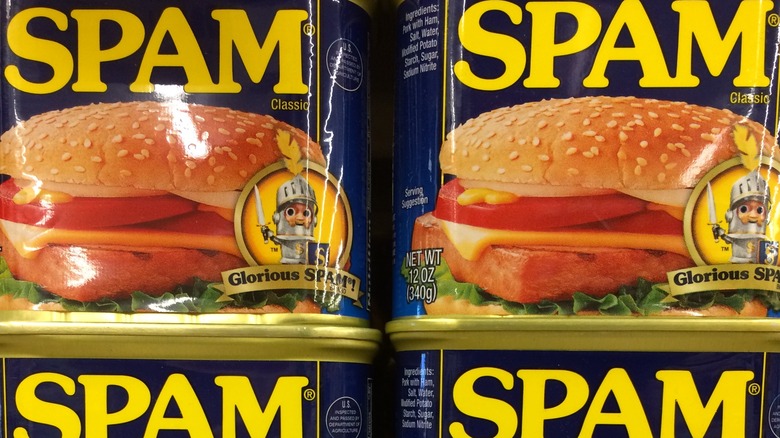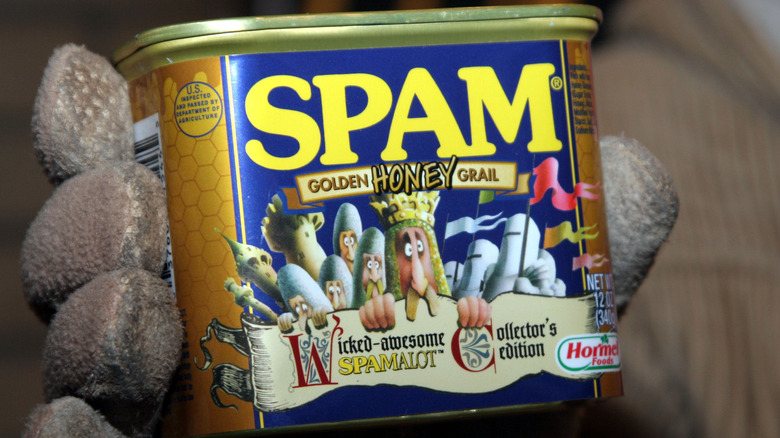Canned Corned Beef Vs Spam: What's The Difference?
You may think all canned meat, like Spam or corned beef, was created equal, but you'd be wrong. The true connoisseur of potted proteins knows that there are some major differences between the two products. The ingredients and manufacturing process produce two unique flavors and textures. Which you like best will depend on your taste buds.
Of course, looking at the in-mouth experience of eating Spam and corned beef only scratches the surface. Clearly, one of the biggest divides between these tins is cultural. Each product has a unique history that has allowed it to flourish in some places, but not in others. Spam is more popular in certain regions while corned beef wins elsewhere. Armies subsisted through multiple wars depending on either Spam or corned beef — which came in their rations, depending on the time period and their nationality. Cooks created recipes specific to one meat or the other on the homefront and in civilian kitchens near military bases. These concoctions are a fusion of cuisines, reflecting regional flavors while using these global products as a fundamental ingredient. Read on and discover the what, where, and how of Spam versus canned corned beef.
Corned beef contains beef, while Spam's main ingredient is pork
The main difference between Spam and canned corned beef is the type of meat that is in the can — from a cow or a pig. The name of canned corned beef is clear about the main ingredient. Spam is slightly less obvious, although the fact that its name rhymes with ham is a bit of a giveaway. This second product contains mostly pork.
You might assume that Spam and corned beef are highly processed with tons of preservatives and additives, but they are much simpler than many other products on grocery store shelves. Both have fewer than 10 ingredients. Libby's canned corned beef ingredients label lists only water, sugar, salt, and sodium nitrite after beef. Spam has a similar ingredient list, swapping out beef with pork, and the extra addition of potato starch. Compare that to Oscar Mayer hot dogs which list 13 ingredients including mechanically separated chicken and turkey along with several additives. Spam and corned beef look pretty good under those circumstances.
Sodium nitrite is the sole additive in Spam and canned corned beef, and it is also present in most other cured meats. These are products like hot dogs, bacon, and pepperoni. There are some health concerns surrounding this preservative, since research links it to cardiovascular disease. That being said, eating excessive amounts of animal protein in general, things like beef and pork, may also cause heart disease and high blood pressure. If you're worried, just avoid eating canned meat in excess.
Spam is cheaper than canned corned beef
Spam is cheaper than canned corned beef — compare the per pound prices of around $5 versus about $8. The fact that pork is usually cheaper than beef explains the difference in price. You'll probably find pork chops for between $5 and $6 a pound in the fresh meat section. Meanwhile, only ground beef has a comparable price with other cheap cuts, like beef eye round costing at least $8 per pound. Meat prices depend on the amount of feed animals need over their lifetime up until slaughter. Producers raise pigs only five or six months while most cattle live between 12 and 22 months. That makes cows and thus beef far more costly whether the meat comes in a refrigerated tray or a can.
Interestingly, the per-pound prices of fresh meat versus canned meat are similar. That might make Spam look like a terrible deal — it costs about the same as pork chops, but has worse taste and texture. This is slightly misleading. During canning, manufacturers cook the meat, so the weight on the label is the amount the consumer can eat. Meanwhile, if you buy fresh meat and cook it, it loses weight and size. For example, 1 pound of raw ground beef reduces to ¾ of a pound when cooked. That means cans have a better price-quantity value, especially canned corned beef. Better value is not true in regards to quality of the base ingredients, nutrition, taste, and texture, though.
There are many flavors of Spam, but not so for corned beef
Anyone who searches canned meat on any major grocery store website will find several flavors of Spam, and a much smaller selection of corned beef. Hormel's website lists 12 types of Spam from classic to teriyaki, jalapeño, and maple. Most flavors received an average of four and a half stars from reviewers on Amazon. Redditors had a lot of opinions about which type was best. Many recommended classic, low-sodium, bacon, tocino, or teriyaki. Korean BBQ was an exception since consumers did not love this variety of Spam as much as others. They rated it around three and a half stars on Hormel's website. The biggest complaints were about the unauthentic Korean spices and the unpleasant flavor combination.
If you head to the canned goods aisle for corned beef, though, your flavor options are just three: classic, a low-sodium version, and canned corned beef hash. You will still have a wide range to pick from, though, since so many companies make canned corned beef. That creates a wider market with more variation in quality and price than is available for Spam. Libby's may be the biggest name in the corned beef game, but Goya, Iberia, Ox & Palm, Armour, and even Hormel all pack and sell it too.
Spam is squishy while corned beef is stringier
The textures of Spam and canned corned beef are undeniably different. Spam comes out of the can in a unified block. It's squishy, spongey, and easy to cut into slices. Canned corned beef on the other hand is drier and stringier. You can easily identify individual meat fibers. Where Spam is homogeneous, canned corned beef seems more heterogeneous. It doesn't always come out of the can in a whole block and isn't as easy to cut into slices.
The difference in texture between the two canned meats has to do with the difference in ingredients, and also with the canning and cooking process. Machines grind pork and mix it with salt and potato starch to make Spam. Then, factories fill cans with this meat paste, seal them, and cook the product in a pressure cooker. The potato starch is likely the ingredient that gives Spam a uniform, solid texture. Canned corned beef plants use a similar, but not identical process. There, raw beef is cut, cubed, or shredded, but not ground into a paste. They don't add starch so the final product has a looser texture. Like Spam, though, corned beef is most often cooked after factory mechanisms pack the can.
Libby's packed corned beef in a rectangular can long before Spam existed
Corned beef and Spam cans have interesting shapes, nothing like the cylinder used for other canned food. Factories usually pack the first type of meat into rectangular cans, larger at the base than the top with a key attached. Spam comes in an untapered, oblong receptacle with rounded corners. The resulting shape is somewhere between an oval and a rectangle and has a pull ring for easy opening. A long road led to developing these containers.
First, innovator Nicholas Appert of France packed meat into heavy glass and ceramic containers. It was the early 1800s and he won a cash prize for his idea from Napoleon Bonaparte. The French emperor needed a more reliable way to feed soldiers and canned meat seemed promising. Then, English inventor Peter Durand proposed using metal cylinders instead. Others improved upon Appert and Durand's ideas over the next century. In the 1870s, manufacturers, like Arthur A. Libby and William J. Wilson, started putting preserved meat in a rectangular can. They may have thought it would be easier to remove the product and then slice evenly. Interestingly, Wilson wanted to patent this model, but the commissioner at the time refused, citing that the St. Louis Beef Canning Company and Robert D. Hunter already used this type of can. Fifty years later, Hormel put ham in a can. It was the 1920s and he imitated earlier canners, using a rectangular design.
During WWII, British soldiers ate more corned beef and Americans ate more Spam
Nicolas Appert invented canned meat to feed soldiers and sailors when fresh food was unavailable and more than a century later, WWII put millions of soldiers from around 70 countries in that situation. Governments used these preserved products to sustain militaries far from home. Britain fed soldiers mainly canned corned beef and hardtack. Men on the front lines created recipes to make the dry, stringy canned meat more palatable. Stew with ground hardtack crumbs, corned beef, and the occasional vegetable was preferable to eating the stuff cold from the can.
The United States, on the other hand, provided its men with Spam and Hormel's infamous K-rations (canned ham with veggies and eggs included). The company had just put Spam on the market in 1937 and that was a lucky strike because of the coming war. By 1944, the U.S. government was purchasing 90% of the company's products to feed troops. In total, Hormel shipped around 133 million cans overseas to feed U.S. troops, allied troops, and civilians. While Spam tasted better cold than canned corned beef did, the troops still didn't love it. Hormel's website makes no secret of the fact, sharing this quote from Dwight Eisenhower: "I ate my share of Spam along with millions of soldiers. I'll even confess to a few unkind remarks about it. As former Commander In Chief, I officially forgive you your only sin: sending us so much of it."
Spam and corned beef are popular in different places
Your canned meat preference depends on your location. If you're from Puerto Rico or Samoa, your family probably has several well-loved corned beef recipes, like hash or stew. If you're from Korea or Hawaii, you probably eat Spam in musubi, sandwiches, or army base stew (in the photo above). Filipinos eat corned beef for breakfast as cornsilog or and Spam in Spamsilog.
History and geography forced these regions to develop a taste for canned protein. The British navy likely introduced canned corn beef to the Caribbean in the 1800s while combating the slave trade. The locals may have been grateful when it sustained them through hurricane season. South Korea began its love affair with Spam because of the American soldiers stationed there. Many traded rations for services from locals. Islands, like Samoa and Hawaii, hosted the militaries and had limited access to fresh meat, so these products got popular quickly. Areas with cattle and abundant fresh meat, on the other hand, remain uninterested by Spam and corned beef. Fray Bentos, Uruguay is an example — you won't find canned meat easily in the grocery store there. Ironically, one of the largest corned beef canning factories in the world opened in Fray Bentos in the 1863. The town revolutionized the canned meat industry. Despite that, the locals have so much access to fresh beef that canned corned beef simply isn't a part of their diet.
Spam has a more mysterious name than corned beef
Spam is catchy, while canned corned beef is a mouthful. It's one syllable up against three and the final "m" in Spam leaves your mouth in position to say, "Mmmmmm, this is good." "Ffffff" from corned beef sounds like an angry cat. However good or bad it feels to say it, 90-some years ago, the word Spam was meaningless. Ever since the product came out in 1937, though, people have wanted to know what it means. Hormel lends to the mystery surrounding the made-up brand name, Spam, saying, tongue-in-cheek, "The real answer is known by only a small circle of former Hormel Foods executives. And probably Nostradamus." That's on the official website FAQs. According to Time magazine, though, the name Spam combines "spiced" and "ham." That article's source is the Spam Museum and credits Ken Digneau for creating the name.
Although less appealing sounding, canned corned beef's name also provokes questions. For example: if there's no corn in it why is it corned? The term refers to the kernel-sized salt used to preserve meat, not the yellow vegetable. Alternatively, British and Australian soldiers called this food bully beef. It's not because it was for bullies, though. The term is likely an anglicization of the French "bouilli" meaning to boil. The French invented canned food specifically to feed the military and boiled it to keep it unspoiled. It makes sense that the British military would adopt the foreign term for the food.
Hash and stew are the most common recipes for corned beef
Put the best canned corned beef in the right recipe and it tastes delicious. There is so much more you can do with this ingredient than serve it with cabbage on St. Patrick's Day or put it in Reuben sandwiches.
The recipe for corned beef hash is one of the most popular to make with this ingredient. Make some small cubes of fried potato and then mix in the tinned meat. Cook a while longer and add a fried egg on top. This satisfying breakfast is easy and fast — just about 45 minutes — to make with shelf-stable ingredients you probably already have in your pantry.
Stew is another dish people make with canned corned beef. Every region has its style and every family has their recipe. Some typical ingredients people might add are onions, garlic, potato, carrots, and stock. Using canned meat is faster and easier than making stew with fresh cut stew meat that sometimes needs to simmer for hours to get tender. You may also want to try canned corned beef in dishes like Jamaican bully beef, Puerto Rican alcapurrias, and Filipino cornsilog.
Spam is an ingredient in musubi and fried rice
There are abundant recipes to try with Spam from all over the world. If you've only been eating sliced Spam sandwiches or mixing cubes into your macaroni and cheese, these recipes will blow your mind.
A recipe for Spam musubi is the first one you need to try. This Hawaiian dish puts a slice of the canned ham on a rectangle of rice. Wrapping the whole thing with a strip of nori is the final touch. This Spamcentric delicacy is reminiscent of sushi, but without raw fish.
If you're craving Korean flavors, try this recipe for kimchi fried rice with Spam. This is the perfect thing to whip up if you're short on time and have some leftover cooked white rice in the refrigerator. Sauté the three main ingredients with pepper flakes, and soy sauce for flavor. Then, scramble in some eggs. It only takes about 15 minutes and is incredibly flavorful and filling.
Spam showed up in Monty Python
If canned corned beef and Spam were in a popularity contest, Spam would win hands down. Pop culture loves Spam — the famous Monty Python sketch in a diner with a droning waitress and singing Vikings is one example. Weird Al Yankovic's song, "Spam" is another. There's a museum dedicated to Spam in Austin, Minnesota. There's also an annual food festival in Hawaii — Waikiki Spam Jam — dedicated to the canned product. Even Gordon Ramsay has published a YouTube video cooking a Spam sandwich.
Canned corned beef just can't compete. Its name isn't as fun to say, it tastes worse, and it's more expensive. In 2022, the world consumed more canned pork than canned beef. None of these factors is quite enough to explain why people love Spam's brand so much, though. The canned pork product has a cult following and its fans don't seem ready to abandon it anytime soon.
